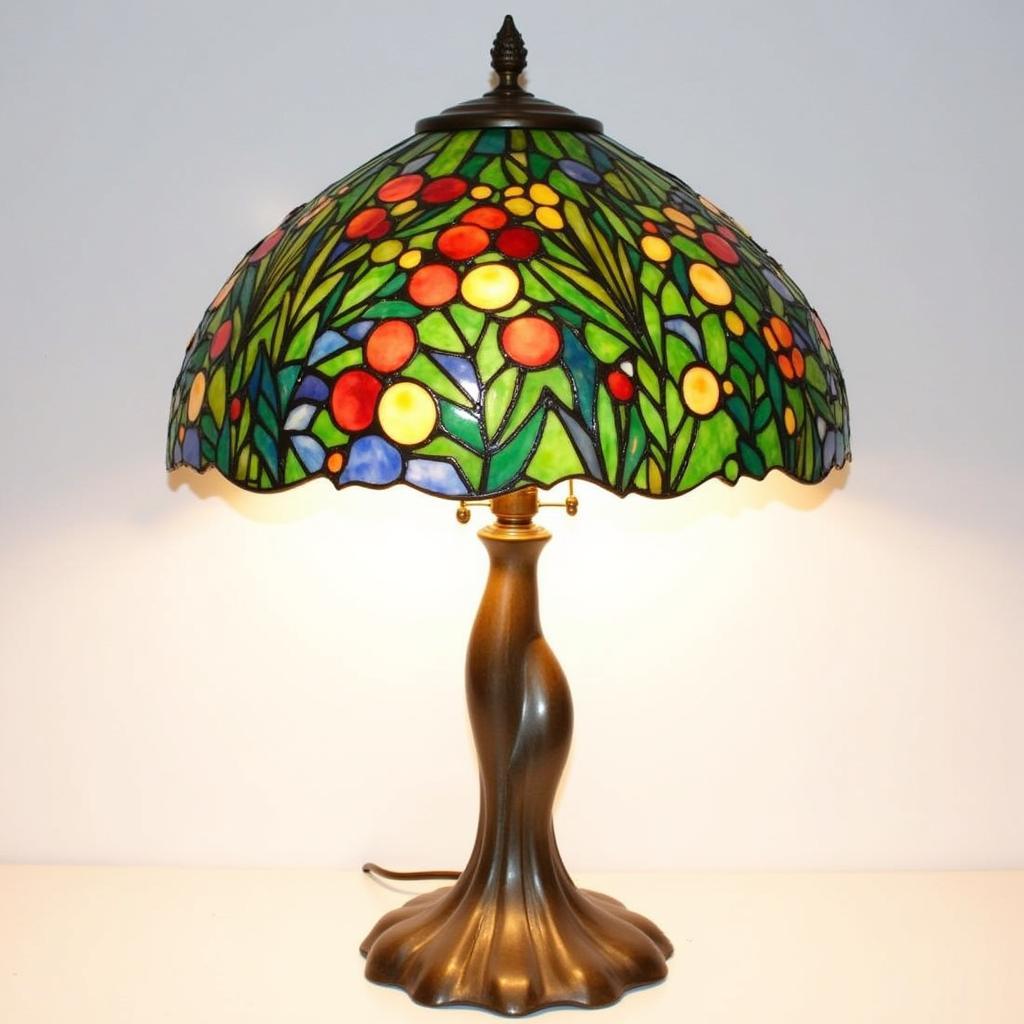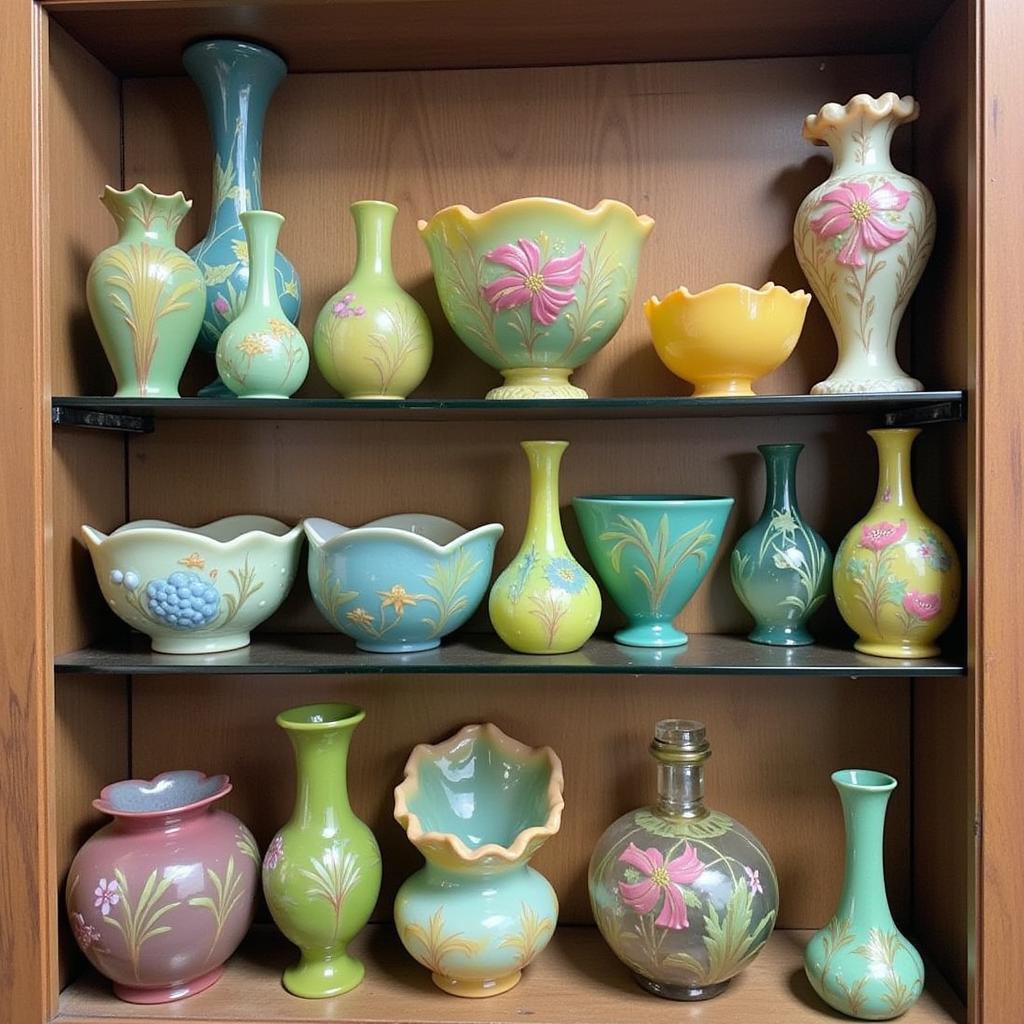Exploring the Alluring World of Art Nouveau Glassware
Art Nouveau Glassware, with its sinuous lines, vibrant colors, and nature-inspired motifs, remains a captivating testament to the artistic revolution that swept across Europe and beyond at the turn of the 20th century. From delicate vases and elegant stemware to striking lamps and decorative objects, Art Nouveau glass transformed everyday items into exquisite works of art. Let’s delve into the fascinating world of this iconic style, exploring its history, key characteristics, prominent artists, and enduring legacy.
The Art Nouveau movement, flourishing from the 1890s to the outbreak of World War I, embraced a new aesthetic that rejected the historical revivalism of previous eras. It sought inspiration in the natural world, drawing upon the flowing forms of plants, insects, and the female figure. This embrace of organic shapes is beautifully exemplified in Art Nouveau glassware, which features swirling lines, asymmetrical designs, and intricate detailing. You might even find inspiration to bring into your own home with some fine art table lamps.
Key Characteristics of Art Nouveau Glassware
What defines Art Nouveau glassware? Several key elements distinguish this style from others. First and foremost is the emphasis on organic forms. Think flowing lines, stylized floral patterns, and depictions of insects like dragonflies and butterflies. Another defining characteristic is the use of vibrant colors, often achieved through innovative glassmaking techniques like iridescent glass and cameo glass. The incorporation of natural elements is also crucial, with seaweed, flowers, and feathers frequently appearing as decorative motifs.
The unique iridescent finish often found on Art Nouveau glassware added a magical quality to the pieces. This effect, achieved through the application of metallic salts to the surface of the glass, created a shimmering, rainbow-like sheen that changed with the angle of light. Similarly, cameo glass, a technique involving layering different colored glass and then carving away the outer layers to reveal the underlying colors, allowed for intricate and detailed designs.
Prominent Artists and Manufacturers of Art Nouveau Glass
The Art Nouveau glass movement was driven by the creative genius of numerous artists and manufacturers. Émile Gallé, a French glassmaker and designer, is considered one of the most important figures in Art Nouveau glass. His works are renowned for their intricate cameo glass techniques and depictions of botanical subjects. René Lalique, another prominent French artist, created stunning pieces characterized by flowing lines and ethereal forms, often incorporating stylized female figures and mythical creatures. Companies like Tiffany Studios in the United States also played a significant role, producing exquisite lamps and decorative objects that epitomize the Art Nouveau aesthetic.
“The essence of Art Nouveau lies in its ability to transform everyday objects into works of art, blurring the line between functionality and beauty,” notes renowned art historian Dr. Amelia Dubois.
What are the Different Types of Art Nouveau Glassware?
Art Nouveau glassware encompasses a wide range of objects, including vases, bowls, plates, stemware, lamps, perfume bottles, and decorative objects. Each piece reflects the artistic principles of the movement, featuring organic forms, vibrant colors, and nature-inspired motifs. You can still find beautiful art glass vases vintage today.
 Tiffany Style Art Nouveau Table Lamp with Floral Design
Tiffany Style Art Nouveau Table Lamp with Floral Design
How to Identify and Collect Art Nouveau Glassware
Identifying authentic Art Nouveau glassware can be challenging. Look for the key characteristics of the style: organic lines, natural motifs, and vibrant colors. Examine the piece for signatures or marks that can help identify the maker or manufacturer. Consulting with reputable antique dealers or experts can also be helpful in authenticating a piece. When collecting, consider focusing on a particular type of glassware, artist, or manufacturer. Researching the history and provenance of a piece can add to its value and significance.
“Collecting Art Nouveau glassware is more than just acquiring beautiful objects; it’s about connecting with a unique period of artistic innovation,” observes antique glass expert Mr. Charles Beaumont.
The Enduring Legacy of Art Nouveau Glass
Art Nouveau glassware continues to captivate collectors and art enthusiasts alike. Its timeless beauty and artistic significance have ensured its enduring legacy. The movement’s influence can be seen in contemporary design, with its emphasis on organic forms and natural motifs continuing to inspire artists and designers today. Whether displayed in museums or cherished in private collections, Art Nouveau glassware remains a testament to the power of art to transform the everyday into the extraordinary. Perhaps art glass orange might be a cheerful accent for your collection.
Conclusion
Art Nouveau glassware stands as a remarkable testament to the artistic ingenuity and creativity of the late 19th and early 20th centuries. Its distinctive style, characterized by organic lines, vibrant colors, and nature-inspired motifs, continues to resonate with art lovers today. From the delicate elegance of Émile Gallé’s cameo glass to the ethereal beauty of René Lalique’s creations, Art Nouveau glassware offers a captivating glimpse into a pivotal moment in art history. Explore the world of Art Nouveau glassware and discover the allure of this exquisite art form. It’s a fascinating journey through a period of exquisite craftsmanship and innovative design, reminding us of the enduring power of art to inspire and enchant. Some collectors even enjoy the unique juxtaposition of art nouveau silver alongside their glass pieces.
 Collection of Various Art Nouveau Glass Objects
Collection of Various Art Nouveau Glass Objects
FAQ
- What is the typical price range for Art Nouveau glassware?
- Where can I find authentic Art Nouveau glassware for sale?
- How can I tell if a piece of Art Nouveau glassware is a reproduction?
- What are some tips for caring for and cleaning Art Nouveau glassware?
- Are there any contemporary artists who are influenced by Art Nouveau glass?
- What are some good resources for learning more about Art Nouveau glassware?
- What are some other art movements that are related to or influenced by Art Nouveau?
Common Scenarios and Questions
Here are some common situations people find themselves in when dealing with Art Nouveau glassware:
- Inheritance: You’ve inherited a collection and aren’t sure of its value or authenticity.
- Accidental Damage: A piece has been chipped or cracked, and you need advice on repair.
- Starting a Collection: You’re new to collecting and want guidance on where to begin.
For those interested in expanding their knowledge, you might be interested in learning more about art craft glassware.
Further Exploration
We recommend looking into other related topics like Art Deco glass, Victorian glass, and contemporary glass art for a broader understanding of the evolution of glassmaking and design.
Contact Us
For assistance or inquiries, contact us at Phone Number: 02462573573, Email: danteum@gmail.com. Visit our location: Savico Megamall, 7-9 Đ. Nguyễn Văn Linh, Gia Thụy, Long Biên, Hà Nội 10000, Việt Nam. We have a 24/7 customer service team.


